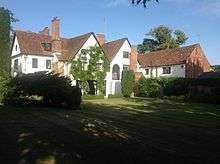Harlington Manor
Harlington Manor is a grade II* listed manor house in Harlington, Bedfordshire.[1][2] The house abuts, and has views over, Bury Orchard, the village common, which itself abuts the Chilterns Area of Outstanding Natural Beauty.
| Harlington | |
|---|---|
Mar2005.jpg) Harlington Crossroads (photo by Peter Roberts, March 2005) | |
 Harlington Location within Bedfordshire | |
| Population | 2,260 (2004) |
| OS grid reference | TL035305 |
| Unitary authority | |
| Ceremonial county | |
| Region | |
| Country | England |
| Sovereign state | United Kingdom |
| Post town | DUNSTABLE |
| Postcode district | LU5 6 |
| Dialling code | 01582 01525 |
| Police | Bedfordshire |
| Fire | Bedfordshire and Luton |
| Ambulance | East of England |
| UK Parliament | |
History

English Heritage, in their listing notice, ascribe Harlington Manor to the 16th century, though recent architectural and documentary examination examination strongly suggests that the house dates, in fact, to the late 14th century and, possibly, to 1396.[3] The Little Parlour contains obviously original, trestle sawn joists. Trestle sawing, as a technique, ceased to be used after the mid-1400's-putting the latest constructional date no later than that time.[4] The house was owned by the Burwell Family of Virginia, from around 1500, but it passed, through intermarriage, to the Wingate family in the early 17th Century. It was, the listing notice claims, owned by Edmund Wingate, mathematician and tutor to Queen Henrietta Maria.[1]
Famously, John Bunyan, the English divine, was interrogated by Sir Francis Wingate and briefly imprisoned in the house, in November 1660. Bunyan was sent to Bedford gaol where, over the next 12 years, he wrote The Pilgrim's Progress. It is thought that Harlington Manor is the only building still standing at which Bunyan is known to have stayed.
Charles II is said to have stayed briefly at the house in late 1660, apparently to thank Sir Francis Wingate for his help in dealing with the potential sedition of John Bunyan.[5]
Harlington Manor was formerly known as Harlington House, its name being changed at some point towards the end of the 19th century.
Architecture
The house is of complex plan, and possesses some fine early 17th century panelling, as well as 4 centred Tudor fireplaces, moulded beams and a Tudor foliate boss. There is an unusual modillion cornice adorning the eastern elevation.[1]
In 1937, the architect, Sir Albert Richardson (responsible for works to Somerset House and the designer of the North London Collegiate School, Manchester Opera House and numerous other high-profile commissions) designed an extension forming a new north wing. Prior to the undertaking of those works, the house had also been extended in the 17th and 19th centuries.[1]
The barn, situated in the grounds of the house, is fully beamed. The roof timbers display apotropaic (ritual) burn marks, probably dating from the 17th century. The structure of the building is likely to be considerably older, however-probably no later than the mid 15th century. The beams show many carpenter's marks-used as an aid to re-assembly of the structure on site, after the timbers had first been cut and erected at the yard of the local wright.
Visiting
The house is private, but intermittently open to the public by private arrangement, or by "Invitation to View".[6] Its exterior possesses a blue plaque, part of the Harlington Heritage Blue Plaque Scheme, commemorating the appearance of John Bunyan at the house.
Harlington Manor operates as an upmarket B and B, via its website www.harlingtonmanor.com. It was rated as one of the top three B and B's in the UK by the London Times[7]
Reference list
- http://www.britishlistedbuildings.co.uk/en-38035-harlington-manor-harlington/
- Historic England. "Harlington Manor (Grade II*) (1137774)". National Heritage List for England. Retrieved 9 August 2014.
- https://www.usask.ca/english/barbauld/related_texts/memoir.html
- Thompson, Joe (2017). "The conversion of structural timbers". Building Conservation Directory. 2017: 126–8.
- http://www.british-history.ac.uk/report.aspx?compid=42450/
- http://www.invitationtoview.co.uk/ Invitation to View homepage/
- "Britain's best cosy winter breaks". The London Times. 25 November 2017.